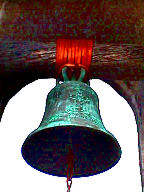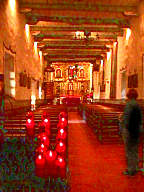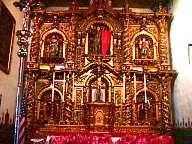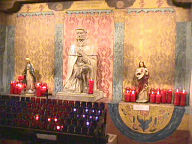The Old Mission at San Juan
Capistrano
Where the Swallows return
to Capistrano
San Juan Capistrano, CA
December 17th, 2002
While  hanging
out in the Huntington Beach area we decided to run down and see one of those wonderful
old missions that were built several centuries ago. Looking back at
early post-Columbian history of the west coast we learned that Spain made the
first European in-roads along the California coast in the 1700s. While
taking advantage of the great harbors around Los Angeles and San Francisco they
paid little attention to the northern part of the coast with its great forests
and abundant animals. These were years of turmoil in Europe and money was
the main reason for coastal exploration. Gold was the calling card.
Little development occurred until Spain realized that Russia, which had found a
way across the Baring Straights
was harvesting fur animals, extensively in the Alaska territory. As time
passed Russia, whose only interest in the area
hanging
out in the Huntington Beach area we decided to run down and see one of those wonderful
old missions that were built several centuries ago. Looking back at
early post-Columbian history of the west coast we learned that Spain made the
first European in-roads along the California coast in the 1700s. While
taking advantage of the great harbors around Los Angeles and San Francisco they
paid little attention to the northern part of the coast with its great forests
and abundant animals. These were years of turmoil in Europe and money was
the main reason for coastal exploration. Gold was the calling card.
Little development occurred until Spain realized that Russia, which had found a
way across the Baring Straights
was harvesting fur animals, extensively in the Alaska territory. As time
passed Russia, whose only interest in the area was the fur trade, began to thin
out the wild life to a point that new territories were needed. Slowly the furriers
began the long migration south through what is now Canada and finally into
northern California. Spain, seeing this encroachment on what it believed
was its colonial lands, realized its military was far too small and far too
distant to challenge much of what the Russians were doing.
was the fur trade, began to thin
out the wild life to a point that new territories were needed. Slowly the furriers
began the long migration south through what is now Canada and finally into
northern California. Spain, seeing this encroachment on what it believed
was its colonial lands, realized its military was far too small and far too
distant to challenge much of what the Russians were doing.  The Spanish
response was to authorize a series of missions to be built along the California
coast. The job of creating the 21 California missions fell to the
Franciscan Friars. San Juan Capistrano was one of these missions. The main
purpose as the Friars saw it was to spread the word of God throughout the Indian
populations. To this endeavor, the missions were built with a large
enclosure to facilitate many residents. They were the training center as well as
the religious center. The first school in the area
The Spanish
response was to authorize a series of missions to be built along the California
coast. The job of creating the 21 California missions fell to the
Franciscan Friars. San Juan Capistrano was one of these missions. The main
purpose as the Friars saw it was to spread the word of God throughout the Indian
populations. To this endeavor, the missions were built with a large
enclosure to facilitate many residents. They were the training center as well as
the religious center. The first school in the area was inside the mission. The high walls of clay that surrounded the mission
were hollow. Inside these walls were rooms used for storage and for living
space for the local Indians The center of activity for the entire mission was
the chapel. Serra Chapel was built between 1776 and 1778 and was beautifully
constructed. It is the only existing chapel where Father Serra
conducted services. Its arched roof of seven
domes had sheltered worshipers for less than a decade when a tragic
was inside the mission. The high walls of clay that surrounded the mission
were hollow. Inside these walls were rooms used for storage and for living
space for the local Indians The center of activity for the entire mission was
the chapel. Serra Chapel was built between 1776 and 1778 and was beautifully
constructed. It is the only existing chapel where Father Serra
conducted services. Its arched roof of seven
domes had sheltered worshipers for less than a decade when a tragic  earthquake
leveled the beautiful structure, leaving only a part of one dome and the
sanctuary wall. Today, a nearby replica outside Mission walls, serves as
the parish church. There are beautiful bells in the campanario that were cast
between 1796 and 1804. They originally hung in the bell tower of the
Great Stone Church but came crashing down in the earthquake. The two large
bells were severely damaged in their fall from the tower. The largest was
split open. The bell called San Juan was cracked and split open at the rim
line. The result was a clunking rather than a ringing which further damaging the
bells. They have hung in the campanario since 1813. The bells tolled out
the daily lives of the people of San Juan Capistrano. They told them when
earthquake
leveled the beautiful structure, leaving only a part of one dome and the
sanctuary wall. Today, a nearby replica outside Mission walls, serves as
the parish church. There are beautiful bells in the campanario that were cast
between 1796 and 1804. They originally hung in the bell tower of the
Great Stone Church but came crashing down in the earthquake. The two large
bells were severely damaged in their fall from the tower. The largest was
split open. The bell called San Juan was cracked and split open at the rim
line. The result was a clunking rather than a ringing which further damaging the
bells. They have hung in the campanario since 1813. The bells tolled out
the daily lives of the people of San Juan Capistrano. They told them when  to
get up in the morning, called them to religious services, announced midday
break, tolled evening vespers and communicated births, death and other events.
In later years they were used to announce the arrival of the swallows in their
springtime migration to Capistrano. One of the most
impressive parts of the mission was the wonderfully ornate alter in the rebuilt
chapel. The chapel itself is a long narrow inner structure with a single
narrow isle supplying access to benches on either side. Although narrow,
it is quite long. This altar is over 300
years old and is from Barcelona Spain. It was a gift to the diocese of Los
Angeles in 1906. The altar came in 396
pieces It was installed in the Serra Chapel by Fr. O'Sullivan in
1922. The retablo is carved Spanish cherry wood, covered with gesso and
gold leaf. The gold leaf must be renewed every couple of centuries.
The mission is 224 years old so this is indeed a timely event. All around
the mission grounds there are interesting things to explore. There are
Native American displays , as well as a soldier's barracks,
to
get up in the morning, called them to religious services, announced midday
break, tolled evening vespers and communicated births, death and other events.
In later years they were used to announce the arrival of the swallows in their
springtime migration to Capistrano. One of the most
impressive parts of the mission was the wonderfully ornate alter in the rebuilt
chapel. The chapel itself is a long narrow inner structure with a single
narrow isle supplying access to benches on either side. Although narrow,
it is quite long. This altar is over 300
years old and is from Barcelona Spain. It was a gift to the diocese of Los
Angeles in 1906. The altar came in 396
pieces It was installed in the Serra Chapel by Fr. O'Sullivan in
1922. The retablo is carved Spanish cherry wood, covered with gesso and
gold leaf. The gold leaf must be renewed every couple of centuries.
The mission is 224 years old so this is indeed a timely event. All around
the mission grounds there are interesting things to explore. There are
Native American displays , as well as a soldier's barracks,  a
mission cemetery and a wonderful garden and central courtyard.
a
mission cemetery and a wonderful garden and central courtyard.
Laura: While we
don't often get too personal in our web page I just wanted to mention that at
the time we visited San Juan we were going through a personal crisis with Bob
having been diagnosed with a Squamous Cancer on the side of his head. We were
waiting for his surgery when we made this trip with our good friends (and
editor) Lynn and Susie Davis. Needless to say I had a great deal of trepidation
about the outcome of the cancer surgery. When we went into the chapel I saw a
brochure on a "little known" Saint by the name of St. Peregrine. It
seemed that he was the patron Saint of cancer patients. I took this as more than
a coincidence and lit a candle to St. Peregrine. Well, thousands of miles and
many months, later as I write this, Bob is still cancer free. Was it
the prayer or simply the expertise of his surgeon? I'll leave that up to you to
decide, but I'm glad I still have him around to travel life's highways
with.
***THE END***
